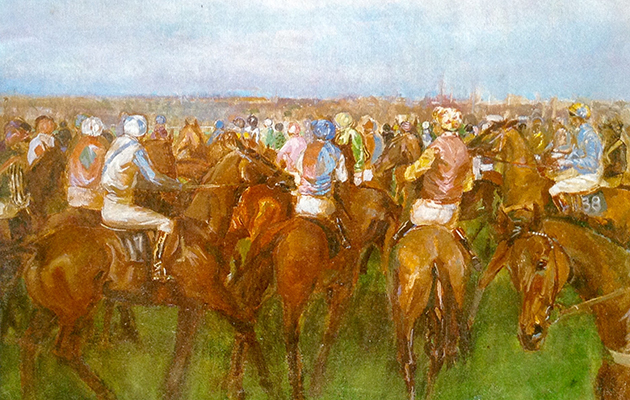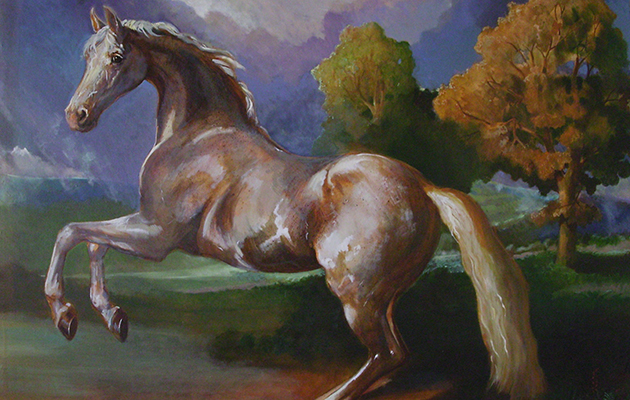The buzz of racing provided a backdrop to Tod Ramos’s childhood, with a palette rather than more conventional toys, he tells Janet Menzies
Growing up in the racehorse training mecca of Lewes, Tod Ramos had his first commission aged 11. Having developed his sporting art alongside a career in race riding, he is now teaching masterclasses in equestrian painting, as he tells Janet Menzies.
For more sporting artists, context and authenticity are vital to Jonathan Pointer. And Debbie Harris’ atmospheric oil paintings were inspired by an early love for dogs and hunting.
TOD RAMOS
In half a century of painting horses, Tod Ramos has brought continuity to equestrian art without ever lapsing into nostalgia. Anyone who has sighed wistfully over the twill jodhpurs and bowler hats of a Munnings equestrian portrait will understand the lure of looking back. Amazingly, the two painters’ lives do indeed overlap by a couple of years.
He confirms: “Munnings was a great pal of my grandfather.” Ramos comes from a family of artists. His father was Theodore Ramos, the Spanish portrait painter, and his mother, Julia Rushbury, a landscape painter, is the daughter of the Sir Henry Rushbury who was keeper of the Royal Academy in Munnings’ time.

Pre-parade ring, Royal Ascot.
Ramos describes his childhood in a racing world that Munnings would have recognised: “I was brought up in Lewes in Sussex, which, at the time, was a mecca of racehorse training. I was very small when I was a child and there were lots of small people wandering round Lewes wearing cloth caps and so I didn’t feel like a misfit. I got a job mucking out for Gordon Smyth, who trained Charlottown to win the Derby. The trainer said ‘get your hair cut’ and I was fitted with my jodhs and cloth cap so I looked the part, even though I hadn’t even sat on a horse. Then I was put up on the gallops pony and I led the yearlings up the gallops.
“The buzz of racing was always there and it was fascinating. With both my parents painting, my brothers and I never had that moment of ‘gosh, I am bored’ because you were given a palette. So I was painting racehorses and gallops when I was only nine or 10 years old. I got a commission from one of the owners to do a painting when I was about 11 and that was my first commission.”

Start of the Grand National, Aintree.
More commissions followed and at the same time Ramos began to be offered rides as an amateur jockey, so the two careers developed together. “The trainer’s farrier had a point-to-point horse and I had the ride on that. I was riding pointers and hunter chasers even while I was still at school. I went on combining studying painting with race riding when I moved to Cheltenham and was with Frenchie Nicholson, David Nicholson’s father. I was studying at the Royal Academy, and race riding at the weekends.”
It was the perfect preparation for the next generation of classic equestrian artists, and even at the time Ramos found himself in awe of the giant footsteps in which he was treading. He explains: “At the Royal Academy school we had access to the Academy’s library and I copied all the studies made by George Stubbs for his The Anatomy of the Horse. They are extraordinary, blood-stained drawings that he made from dissections for the engravings. That was such an important lesson because I was able to touch these drawings and understand the analytical process.”
PAINTING FROM LIFE
The experience would go on to inform Ramos’s mature work, allowing him to paint purely from life. “The idea of a camera is anathema to me. So much sporting art seemed to be based on the copying of photographs, it felt quite wrong to me. I was pursuing the idea of painting through racing. Racing is a proper subject – it is a circus, full of personalities, and it attracted great artists like Degas and Toulouse Lautrec.

Tod Ramos at work.
“This is my mantra in horse painting, that first and foremost it has to be a painting and the subject matter is almost incidental. If you look at a portrait hanging on a wall, it is there because of its artistic merit, it is more than just a likeness. Equally, a racing painting is not just the horses. There is so much – the colours, the characters, the racegoers, the bookies, the architecture… There is such a narrative possibility.”
With contemporary art dominated by installation and abstract movements, Ramos has shared a struggle similar to his equestrian artist predecessors. Just as in his time Stubbs was condemned for his non-classical subject matter, Ramos needed figurative art to be recognised. “The art schools have been very slow to realise that figurative painting has re-emerged. It was a fight in the past to be a figurative painter. Now there are so many traditional elements that are crying out to be taught – right down to the mixing of paints.”

The Open Ditch – Cheltenham.
So Ramos is teaching them. He and his artist wife, Kate Lovegrove, have set up Academy Studios Abroad, offering residential art courses at their studio in Aubais set between the Camargue and the Pyrenees. This May, Ramos will teach a week-long masterclass in equestrian painting, The Tour de Horse. It caters for intermediate and professional painters rather than those of us who cover every shopping list with doodles of horses’ heads. However, there are other courses to be held over the summer, offering the perfect opportunity to step into a world of sporting art that really began about 20,000 years ago in the caves of Lascaux four or five hours’ drive to the north of Aubais.
To find out more about Academy Studios Abroad and its residential art courses in Aubais, France, call 07831 529525 or go to: academystudiosabroad.com





